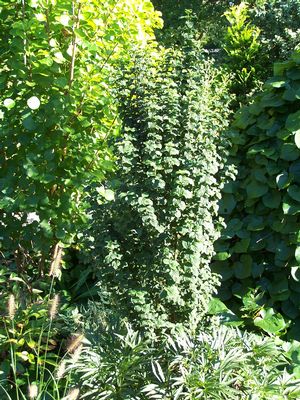View All Plants :: View All DECIDUOUS SHRUBS
Cornus sanguinea 'Compressa'
Bloodtwig Dogwood
Plant Type:
DECIDUOUS SHRUBSCornus sanguinea ‘Compressa’ – 'Compressa' is a most uncommon form of the Common Dogwood with all stems strictly vertical ascending within a narrow framework. The deeply corrugated, coin-shaped glossy green leaves occur densely on shortened internodes turning a dark burgundy in autumn. The flowers are small, dense typical white cymes. Winter stem color is a deep, earthy red-purple. This curious yet beautiful shrub has many applications – from foundation to rock garden, mixed with perennials, grasses or conifers it will add a distinctive flair to your garden. And its narrow, very vertical stature makes it a great candidate for tight spots or an accentual exclamation point. Site ‘Compressa’ in full to nearly full sun planted in fertile soil. Cutting grown.
Please scroll down to Genus Overview for more information.
Characteristics and Attributes for Cornus sanguinea 'Compressa'
Season of Interest (Flowering)
- Spring
Season of Interest (Foliage)
- Spring / Summer / Autumn
Interesting Bark
- Colored
Autumn Interest
- Autumn Leaf Color
Nature Attraction
- Butterflies
- Songbirds
- Honey Bees & Native Bees
Light
- Mostly Sunny
- Full Sun
Attributes
- Specimen
- Accent
Growth Rate in the Garden
- Medium
Soil
- Fertile
Origins
- North America
Propagated By
- Cutting Grown
Genus Overview: Cornus
Cornus. The Dogwoods come in many sizes – low growing shrubs to rounded trees. They are indispensable in a garden with almost all species and cultivars sporting four seasons of interest. Many exhibit richly-colored winter wood, attractive flowers and pretty berries in blue or white. Most offer terrific fall foliage color. The cultivars that offer gorgeous winter bark are especially well-used as background to lower growing evergeens or as foreground shrubs set before conifers, their stem colors glowing in winter against a backdrop of green, black-green, yellow or blue. All that produce flowers and fruit are very fine choices for the wildlife enthusiast. The trees provide nesting spots. When shrubs are grouped together these also provide nesting opportunities for some species of sparrows and even catbirds among others. The trees and shrubs provide nectar for bees and many other pollinators when in flower. Birds relish the late season fruits. All prefer fertile soils that retain some moisture between rain events. All of our offerings are cutting grown.


